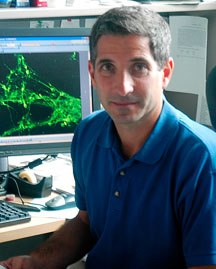

Tweet
Scientists Find Way to Block Stress-Related Cell Death
By Eric Sauter
Scientists from the Florida campus of The Scripps Research Institute have uncovered a potentially important new therapeutic target that could prevent stress-related cell death, a characteristic of neurodegenerative diseases such as Parkinson's, as well as heart attack and stroke.
In the study, published recently in the journal ACS Chemical Biology, the scientists showed they could disrupt a specific interaction of a critical enzyme that would prevent cell death without harming other important enzyme functions.
The enzyme in question is c-jun-N-terminal kinase (JNK), pronounced "junk," which has been implicated in many processes in the body's response to stresses, such as oxidative stress, protein misfolding, and metabolic disorder. JNK also plays an important role in nerve cell survival and has become a target for drugs to treat neurodegenerative disorders such as Parkinson's disease.
In recent studies, JNK has been found to migrate to the mitochondria—the part of the cell that generates chemical energy and that is involved in cell growth and death. That migration, coupled with JNK activation, is associated with a number of serious health issues, including apoptosis or programmed cell death, liver damage, neuronal cell death, stroke and heart attack.
"Activated JNK migrates to the mitochondria in reaction to a stress signal," said Philip LoGrasso, professor in the Department of Molecular Therapeutics and senior director for drug discovery at Scripps Florida who led the study. "Once there, it amplifies the effects of reactive oxygen species that cause significant damage to the cell. We developed a small peptide that intervenes in JNK migration and blocks those harmful effects—specifically cell death."
LoGrasso noted that the team was able to block JNK mitochondrial interaction without harming any other important enzyme processes, such as JNK's impact on gene expression. These findings, LoGrasso said, suggest that this interaction could be exploited in the development of a new drug.
"The peptide we developed will never be a drug, but it is an important new investigative tool that we can use to selectively probe mitochondrial biology," he said. "Our hope is to produce a small molecule that can mimic the inhibitory effect of this peptide. If we can do that, we might be able to selectively inhibit JNK mitochondrial interaction and use it to treat a number of diseases."
The first author of the study, "Selective Inhibition of Mitochondrial JNK Signaling Achieved Using Peptide Mimicry of the Sab Kinase Interacting Motif-1 (KIM1)," is Jeremy W. Chambers of Scripps Research. Other authors include Lisa Cherry, John D. Laughlin, and Mariana Figuera-Losada, also of Scripps Research. For more information, see http://pubs.acs.org/doi/abs/10.1021/cb200062a.
The study was supported by National Institutes of Health and the Saul and Theresa Esman Foundation.
Send comments to: mikaono[at]scripps.edu

Phil LoGrasso led an ACS Chemical Biology study showing the research team could disrupt a specific interaction of a critical enzyme that would prevent cell death without harming other important enzyme functions. (Photo by Bruce Hibbs.)
